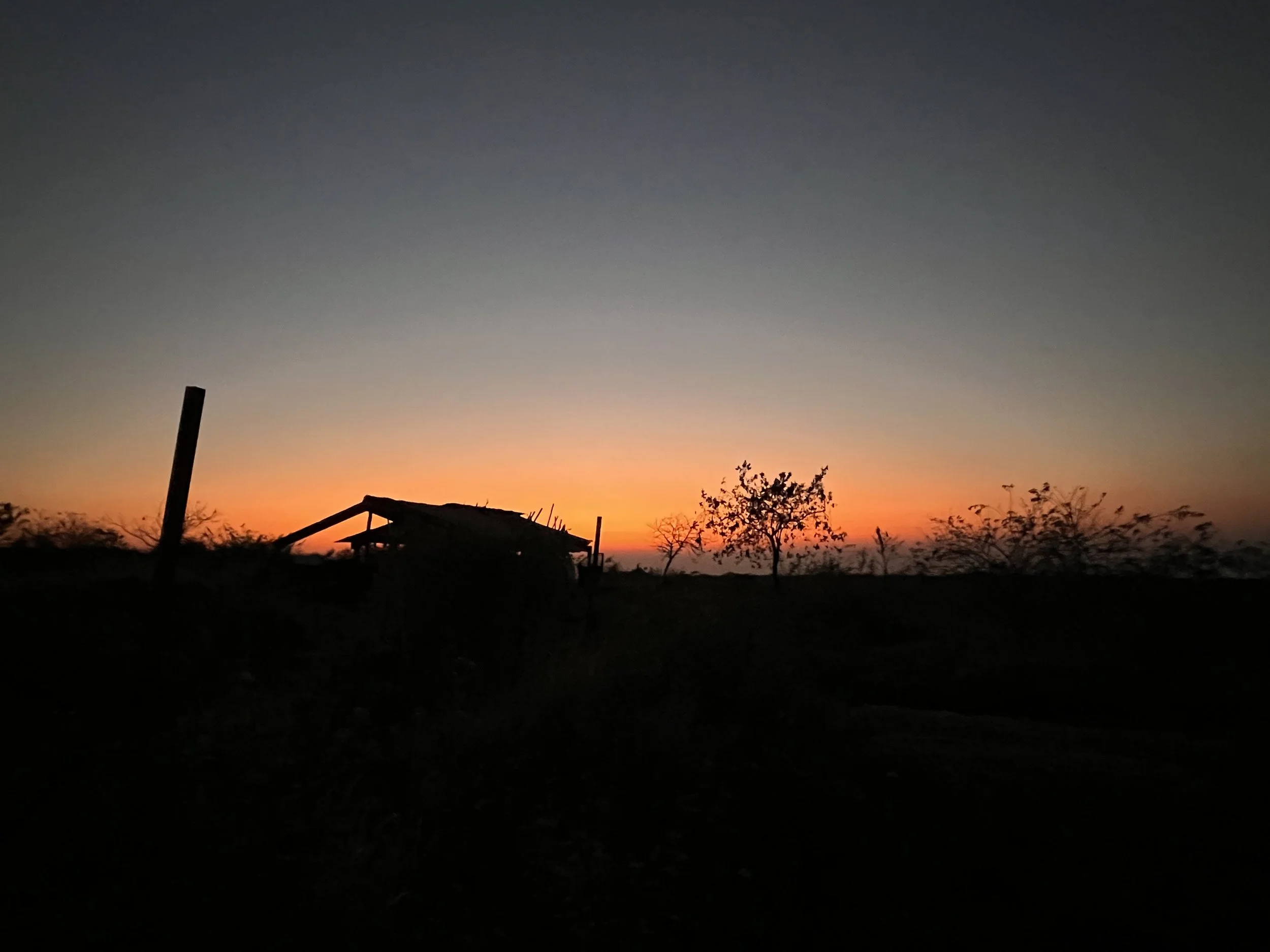(Scroll down to read in English)
以前ブログで書いた通り、2023年後半に、やっと川から水を引くことができて、その後は土を準備するためにコンポストを作ったり、畝を準備したりした。
2024年の年始に日本に一時帰国して、その後ミャンマー駐在を終えた妻と一緒にモザンビークに戻り、畑での作業が本格的にスタートした。
真夏のモザンビークでの畝作り。Making vegetable beds in a hot Mozambican summer day.
妻も一緒に畑仕事を手伝ってくれて、モザンビーク人の従業員と、畝を作り、種を植えていった。
その時期のモザンビークは夏真っ盛り。
南半球なので日本とは季節が逆。
そしてモザンビークの夏は雨季。
土の状況や、気温、日照時間、雨など、さまざまな条件からどんなふうに野菜が育つのか、やってみないとわからないので、まずはいろいろと植えてみた。
ルッコラ、空芯菜、スイスチャード、パクチー、ディル、ニンジン、大根、かぶ、ズッキーニ、ごま、アスパラ、きゅうり、小松菜、ニンニク、アーティチョーク、九条ネギなどなど。
そのうち、うまくいったのは、
ルッコラ、空芯菜、スイスチャード、パクチー、ディル、大根、かぶ、小松菜、九条ネギ。
アスパラとアーティチョークは、食べれるものになるまでにはまだ時間が必要で、今もすくすくと成長中。ニンニクももう少し。
まあまあうまくいったのは、ニンジン、ズッキーニ、きゅうり。
全然ダメだっだのはごま。
こうやって書き出してみると、結構うまくいっている。
すべて無農薬・無肥料。
もともとヤギが育てられていた場所で、土もそれなりに肥沃なのだと思う。
その土を起こし、コンポスト(堆肥)を混ぜて、畝に仕立て、草マルチをしてタネや苗を植えただけ。
日本の自然農法の知見をベースとして、あとは自己流。
以前の投稿で紹介したが、知人のヤギ農家さんの土地を一部使わせてもらって、農園にしている。
土地を所有したりする面倒や、費用もかからず、本当にありがたいご縁。
また、ヤギ農家さんから出る動物の糞や、枯れ草が常に手に入る。
これらを活用してコンポストにしたり、マルチにしたりしている。
今年生まれた子やぎちゃんと、見守るママ。A newborn baby goat and her mother.
そして野菜は、一部は販売することができた。
ヤギ農家さんがチーズを卸している、マプトの有名レストランが、ルッコラとディル、パクチーを買ってくれた。
またモザンビークで働く日本人の方々に向けても、ルッコラ、パクチー、大根、かぶ、小松菜、九条ネギ、チャードなどを販売した。
大根やかぶといって日本人が好む野菜は、モザンビークでは需要があまり無いので(中国人スーパーに行けば売ってるけど)、直接日本人の方々に販売・配達した。
8ヶ月ほどやってみて、野菜を育てることは、思った以上にうまくいった。
一方思った以上に大変だったのは、収穫、収穫してからお客様に届けるまでの保管や梱包、商品をどのように届けるか、そしてこのビジネス全体がいかに収益を作り出すのか。
配達日の車の中。My backseat on the day of vegetable delivery.
モザンビークは、農業が盛んな国。
私が住んでいる田舎の方でも、いろいろな場所で野菜が育てられ、道端でも売っている。
そして安い。売っている人たちが、ちゃんと生計を立てられているのかはわからない。
トマト、ピーマン、玉ねぎ、きゅうり(太いやつ)、キャベツ、ニンジン、かぼちゃ、ニンニク、などなどは大体いつだって手に入る。
もちろん隣国の南アフリカからの輸入品もたくさんある。
私が作った野菜は、モザンビークでは育てていない野菜が中心で、そこで差別化を図ることはできる。
いい野菜をつくればレストランも買ってくれる。
ただし、まとまった量での、安定した生産が必要なので、今の畑の規模をさらに拡大する必要があるし、技術をもっと上げていく必要がある。
また、もっと効率的にお野菜を届けられるように、収穫から保管・梱包・配送までの仕組みをよりしっかりと作る必要がある。
それでも、初めての自分が立ち上げた農業ビジネスで、レストランや個人にちゃんと野菜を販売することができたのは、大きな成果。
何より、多くの人に野菜が美味しいと言ってもらえたことは、嬉しかった。
自分の生活においても、自分の畑の野菜を普段から食べるようになり、外から野菜を買うことが殆どなくなったし、友人たちにも野菜をプレゼントすることもできるようになった。
畑を通じて、とても豊かな生活が手に入った。
私の農園プロジェクトの中には、畑だけではなく、フルーツやコーヒーの育つ森林も作る計画も入っている。
これは昨年勉強したパーマカルチャーからインスパイアされたもの。
ただし時間がかかるもので、辛抱強く取り組む必要がある。
コーヒーについては別途、ゆっくり書きます。
そしてこの農園プロジェクト、今後どこに向かうのか。
これについても、私の今後の人生プランも併せて、後日書きます。
今年に入ってようやく、本格的に始まったモザンビークの田舎町での私の畑が、思った以上の成果を挙げたことを祝して、本日の投稿は終わります。
早朝に農園に来ると、こんなご褒美が。A little treat in showing up early to the farm.
My last blog was in late 2023, where I wrote about how I was finally able to draw water from the river.
Since then, I have been working on preparing the soil, which includes making compost. Once the compost was ready, we started making vegetable beds.
At the beginning of 2024, after visiting Japan for the new years, I returned to Mozambique with my wife, who had just finished her assignment in Myanmar.
From there, our work in the farm started in full swing.
My wife helped me work the fields with me, along with my Mozambican staff, and we made vegetable beds for sowing our seeds.
It was the height of summer in Mozambique; the seasons are opposite to those in Japan since we are in the southern hemisphere.
And summer in Mozambique is the rainy season.
We didn't know how the vegetables would grow under the conditions here, such as soil conditions, temperature, hours of sunlight and rain, so we just gave it a try.
We planted a variety of vegetables, namely arugula, Chinese water spinach, Swiss chard, coriander , dill, carrots, daikon radish, turnips, courgette, sesame, asparagus, cucumber, Japanese mustard spinach, garlic, artichokes, Japanese leeks, etc.
Of these, those came out well were arugula, Chinese water spinach, Swiss chard, coriander, dill, daikon radish, turnip, Japanese mustard spinach and Japanese leeks.
The asparagus and artichokes need more time for the harvest and are growing well at the moment. Garlic is almost ready.
The ones that did fairly well were carrots, courgette and cucumbers.
Sesame didn’t grow well.
When I look back like this, overall we had a good turnout.
Everything is pesticide and fertiliser free.
The area was originally used for raising goats, so the soil may have been very fertile already.
Our method is simple, we till the soil, mix with compost, made vegetable beds, covered with grass mulch and planted seeds/seedlings.
The method is based on the knowledge of Japanese natural farming + some improvisations.
As mentioned in my previous post, we are using a part of the land that is used by my friend goat dairy farmer.
It is such a precious opportunity for me, as I don’t have to go through the hassle and expense of owning land in Mozambique.
In addition, manure and dried grass cuttings from the dairy farm is always available. These are used to make compost and for mulch.
We even managed to sell some of the vegetables we produced.
A well-known restaurant in Maputo, which purchases cheese from the dairy, agreed to purchase arugula, dill and coriander from my farm.
Daikon radish, turnips, Japanese mustard spinach, Japanese leeks and Swiss chard were also sold to Japanese people working in Mozambique.
Vegetables such as daikon radish and turnip, which are mostly preferred by the Japanese and not so much in Mozambique in general, were sold and delivered directly to the Japanese people.
Eight months of growing vegetables went quite well to my surprise.
On the other hand, harvesting, storage and packaging, transportation, and creating profit form this whole business were the challenging bits.
Mozambique is a country with lots of agricultural activities and farmers.
In the countryside, vegetables are grown in many small/large scale farms and sold on the roadside.
And they are quite cheap.
I’m not sure if the farmers are making a living from their sales…
Tomato, pepper, onion, cucumber, cabbage, carrot, pumpkin, garlic, etc. are common.
In addition, we have plenty of imported stuff from neighbouring South Africa.
Most of the vegetables from my farm are not commonly grown in Mozambique, which gives me an edge in the market.
In addition, if I can produce good quality vegetables, restaurants could be interested in buying.
But for the business to be successful, I need to increase my production while maintaining the quality.
We also need to establish a better system from harvesting, storage, packaging and delivery, so that we can harvest and deliver fresh vegetables efficiently to the customers.
Nevertheless, I am proud to be able to sell vegetables to restaurants and individuals in the first agricultural business I set up.
Nothing is happier to hear people telling me that they enjoyed eating my vegetables.
In my everyday life, I eat the vegetables from my own farm and I hardly buy any vegetables from the shops anymore.
I can also share vegetables as gifts to my friends.
My life became very abundant with the farm.
My farm project includes plans to create not only vegetable beds, but also a forest where fruits and coffee can be grown.
This part is inspired by the permaculture design method, which I studied last year.
This bit will require much more time and needs to be worked on patiently.
I would like to write about growing and producing coffee in a different post.
And where is this whole farm project going from here?
I will write about this later as well with my future life plan.
For today, I would like to close this post by celebrating my unexpected achievements from my little farm in rural Mozambique.













